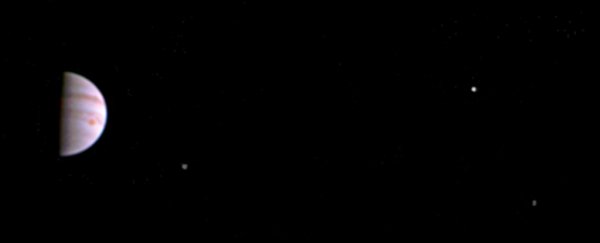NASA's Juno spacecraft has just sent back its first visible-light photo of Jupiter after arriving at the gas giant on 4 July.
Even though high-resolution images are still a few weeks away, JunoCam – the camera on board the craft – is fully operational and ready to capture never-before-seen views of the planet.
"This scene from JunoCam indicates it survived its first pass through Jupiter's extreme radiation environment without any degradation and is ready to take on Jupiter," says principal investigator Scott Bolton, from the Southwest Research Institute in San Antonio. "We can't wait to see the first view of Jupiter's poles."
Captured on 10 July, the new image was taken 4.3 million kilometres (2.7 million miles) away from Jupiter during Juno's first leg of capture orbit, which will last 53.5 days in total.
In the image, you can see a good bit of Jupiter's atmosphere – including the famed Great Red Spot – along with three moons: Io, Europa, and Ganymede, providing a unique first-look at the planet before Juno moves in closer to capture high-resolution images in August.
 NASA
NASA
"JunoCam will continue to take images as we go around in this first orbit," says co-investigator Candy Hansen, from the Planetary Science Institute in Arizona. "The first high-resolution images of the planet will be taken on August 27 when Juno makes its next close pass to Jupiter."
JunoCam, according to NASA, is basically Juno's eyes, meaning that it will provide colour, visible-light images that will hopefully help the public understand and follow the mission as it unfolds.
"JunoCam was included on the spacecraft specifically for purposes of public engagement; although its images will be helpful to the science team, it is not considered one of the mission's science instruments," explains the team.
This means that we will get to see many different sides of Jupiter, giving a more complete view of the planet than other missions in the past. During its stay, Juno will orbit the gas giant 37 times, providing a plethora of data (and awesome images) for researchers back here on Earth.
Even though the new photo is the first image beamed back to Earth from Juno, it's not the first tantalising piece of media. In June – right as it crossed into Jupiter's magnetic field – Juno sent back some incredibly creepy audio recordings of supersonic solar winds.
The NASA team is currently working to upload more JunoCam images for us to enjoy. Until then, you can hold yourself over by checking out this video NASA made about Juno's approach and the Galilean moons featured in the photo.
